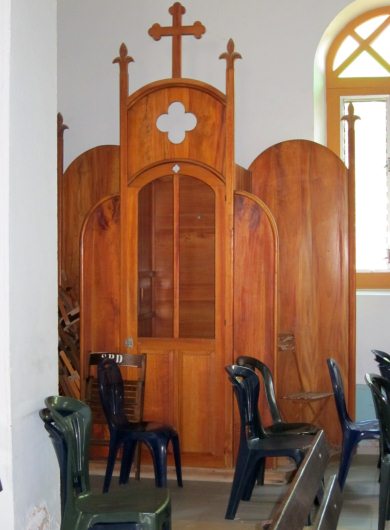Deshaies

|
Deshaies
ïWe have only anchored here in Deshaies (Day Hay) as an overnight rest stop to split a journey north or south, in fact a couple of times 'yellow flagging' (that means not logged in with Customs and Immigration - perfectly allowable so long as you don't go ashore). This time we arrived from Iles des Saintes and fancied exploring. Deshaies is is a commune in the French overseas region and department of Guadeloupe, in the Lesser Antilles. It is on the northwest coast of Basse-Terre Island. The inhabitants are called Deshaisiens.
 
We have had some rain but Robert has made up for it

As we dinghied in, we saw this poor girl groaning under the weight of all her visitors - slightly low at the back end
A local boat having her bottom cleaned. The church as we got closer
History: Deshaies, and its littoral zone of the Large Cape, preserve the vestiges of the primitive vegetation of Guadeloupe at the time of Christopher Columbus' arrival on the 4th of November 1493. The deepest bay of all the Caribbean coast and best naturally protected, it was used by pirates and corsairs - there rumoured to still be treasure on the island. In 1635, colonists landed at Allegre point, at the north end of the island. This part of the coast was very damp; Deshaies is an integral part of a wooded territory extending from Pointe Noire to Baie-Mahault. On the site of the current borough was the plantation of Potherie, one of the richest on the island in 1686. Ten years later the sugar plantations fell to the English. The geographical configuration makes traveling to the district difficult, so inhabitants formed their own community, even to their own militia. The borough was given two cannons on the 1st of April 1730 and established as a community by the will of the Governor in 1732.

 
The town church was consecrated on the 29th of June 1733 and dedicated to Saint Peter and Saint Paul. I agreed with Bear when he said - isn't it lovely that churches in the Caribbean always have the doors not only unlocked but open and welcoming - and you can't buy flowers like these in Tesco.

The view from the church steps shows a fusion between French and Caribbean
Deshaies was economically disorganised by Victor Hugues' conquest and the abolition of slavery. The majority of the inhabitants took up arms for the revolution, but the island remained in the hands of the royalists. The 19th century Napoleonic era was not good for Deshaies because it was the zone in which a Caribbean empire developed. Its distance from the capital Basse-Terre made Deshaies vulnerable despite its strategic position. After the naval battle in the bay between French and English on the 5th of September 1803, the borough and the coastal properties in the vicinity were devastated by the English. The war combined with malaria, which was endemic in the area, made people fear living here. Thirty years later - four years after the abolition of slavery, there was only one sugar plantation, Guyonneau, belonging to Caillou.
  The commune in 1852 saw periods of tension. The opposition between
Caillou and the black farmers on his plantation, were supported by the
priest of the parish, Lettre, became the working class struggle against the
wealthy classes, and of the religious authority against the administrative
authority. The government of the colony, the Minister for the Navy and the
Colonies, feared Deshaies would not support him and maintained correspondence
with his superiors. Once law and order had been returned, the ministry ordered
the deportation of the priest. The ministry created a police station squad
maintained by the governor in 1877, despite the refusal of the Council General.
Between the time slavery was abolished and the Second World War, ignorance
remained the principal obstacle to the development of this community.
Appointment to the civil or religious administration of Deshaies was regarded as
a disgrace to the person so appointed. Deshaies remained insulated and
marginalised. There has been a road connecting the chief towns of the leeward
shore since 1922, but it ended in Pointe Noire, the commune bordering Deshaies.
The road was only extended to Deshaies in 1957. Climate: Like any other Eastern Caribbean town, Deshaies experiences quite evenly spread rainfall during the year, with a wetter season between July and November which coincides with hurricane season. The town receives sixty to a hundred inches of rainfall. Tropical heat is the norm, bringing constant highs of around thirty two degrees centigrade that drop to twenty degrees centigrade at night. In fact chippy enough to wear a tshirt AND the quilt cover. It didn't put swampy off his stride though. HUH You keep to the deep end and I'll keep to the shallow end. I'm not that bad, Am I ? No comment, I'm just pleased I can swim.
 
Economy: Mixed crops are grown such as vanilla, sugar, coffee, cocoa and
bananas. Fishing is an important industry where different types of fish can be
bought at the mini-market. Tourism is booming and hotels and restaurants are
located nearby. There is a craft industry where wooden souvenirs can be
purchased in shops. Aggregate extraction is done. The road
out of town. One of the hotels.
  The electric box, less
spaghetti than some, but still open to the elements
   We saw this cafe on the way in and fancied a roti for
lunch. Within minutes of sitting down the place was full. Good food in a pretty
room
  The view and 'happy boy' - a wow - how lucky we
are
 The girl (on the left) turned for us to see
her
  The beach (not up to much) and wash
day
 Just for you Alex - a pirogue in the
harbour
ALL IN ALL A SMASHING
DAY
A NICE SOJOURN IN A LOVELY LITTLE
TOWN
|






